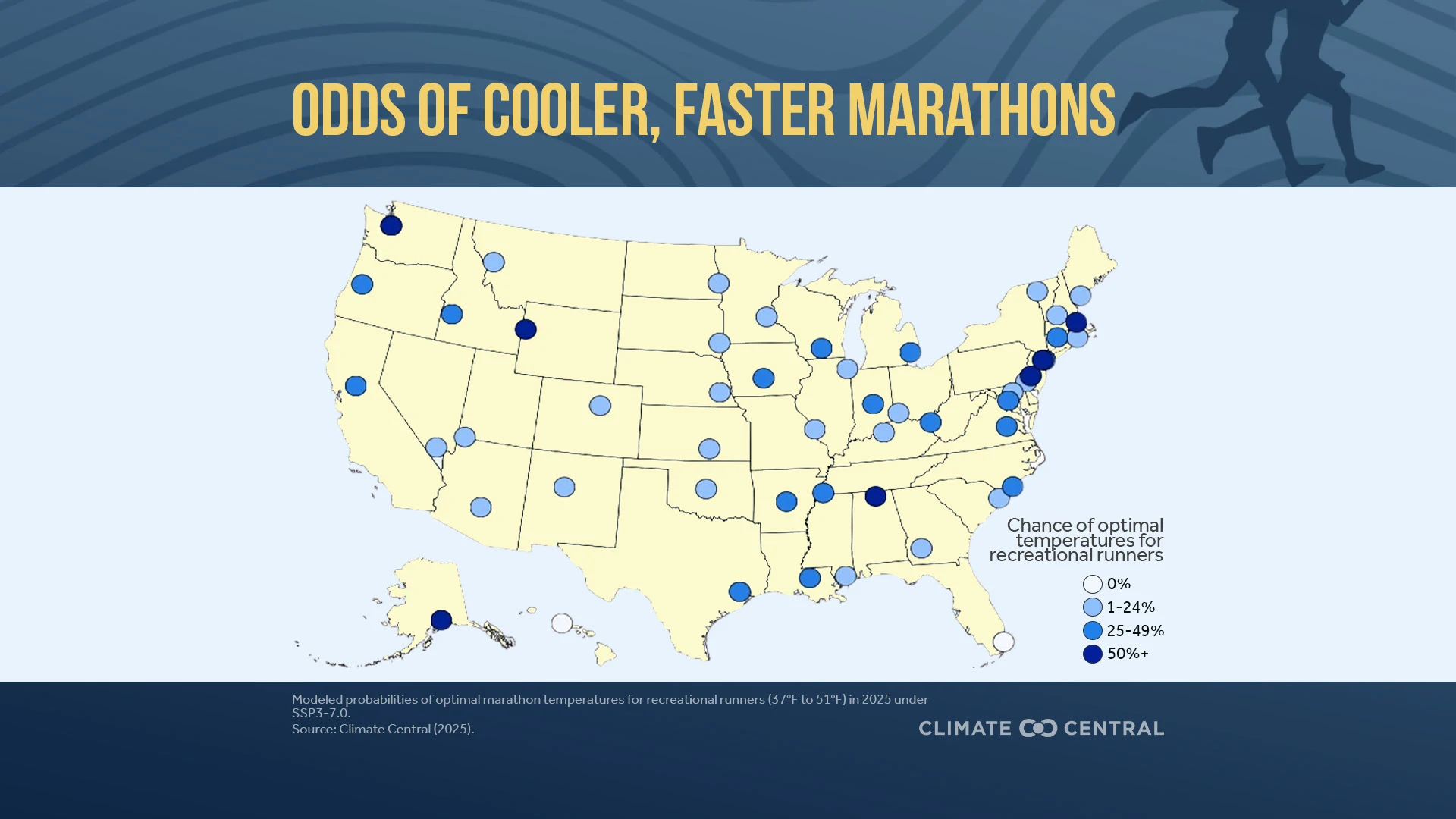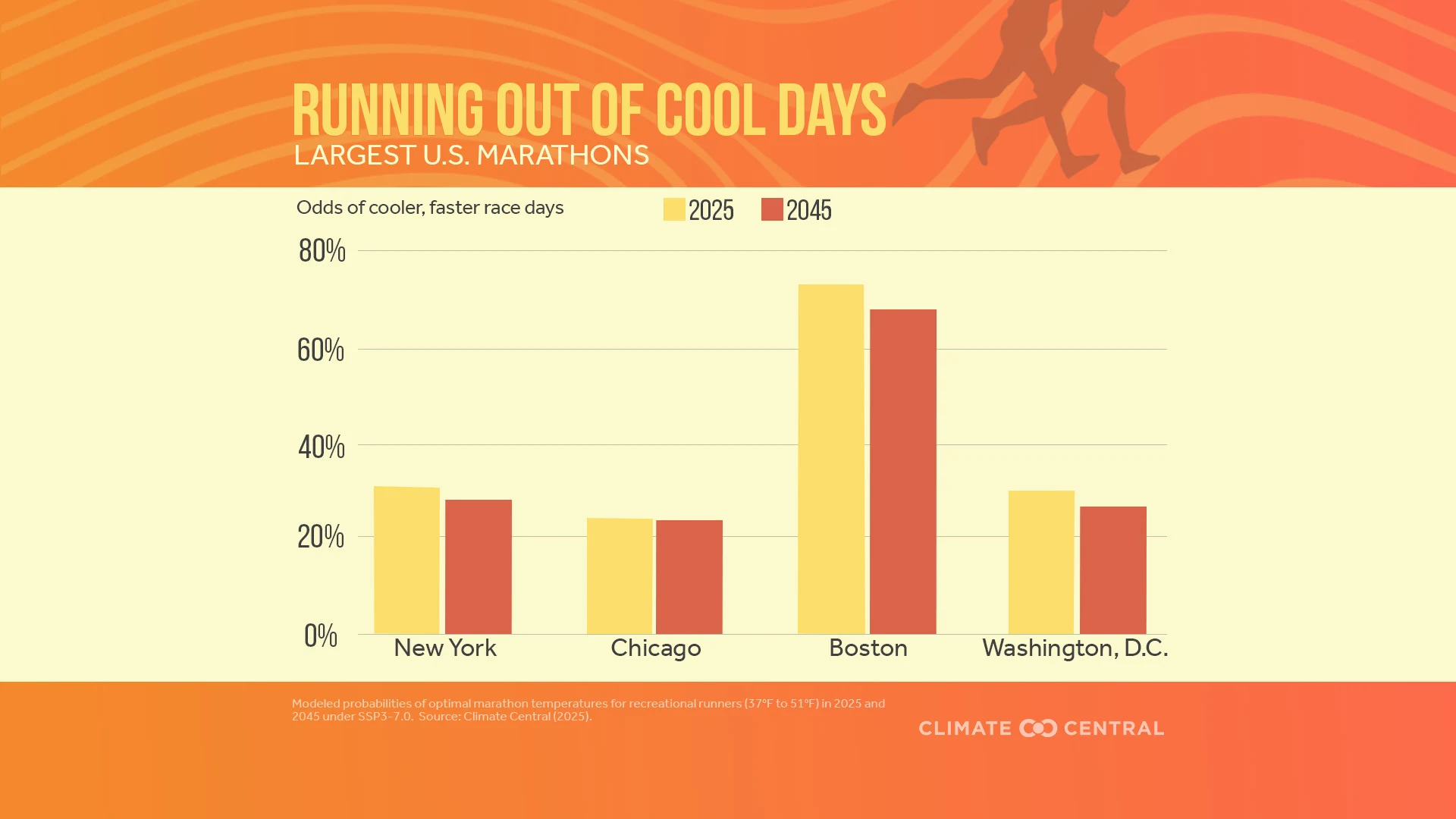
Climate Matters
Urban Heat Hot Spots in 65 Cities
New Climate Central analysis shows where urban heat is most intense in 65 major cities that account for 15% of the U.S. population.
Climate Matters•October 28, 2025
New Climate Central analysis of 221 marathons shows that the cool race-day temperatures that help runners perform their best are becoming less common as the planet warms.
For recreational runners in U.S. marathons, the odds of racing in cool, optimal temperatures are already slim (27% on average) — and likely to shrink with future warming.
If planet-warming pollution remains unchecked, by 2045 optimal race-day temperatures would become less likely in 46 of the 51 U.S. marathons analyzed.
At the TCS New York City Marathon — the world’s largest — the odds of optimal race-day temperatures would decrease between two and five percentage points by 2045 for both recreational and elite runners.
More than 1 million people worldwide finish a marathon each year, and the world’s largest will take place in New York City this weekend.
As thousands head to the starting line to chase their personal best or a place on the podium, race-day temperatures could be a deciding factor. A 2012 study found a “sweet spot” of cool race-day temperatures where marathon runners are fastest.
But the chances of these optimal temperatures are shifting as the planet warms, according to new Climate Central analysis of 221 marathons around the world.
Read the report: Running Out of Cool Days.
Explore the data for all 221 marathons.
For most marathon runners, cooler temperatures are key to crushing a personal best. Speeds decrease at temperatures above or below an optimal range due to increased strain on the body from internal temperature regulation.
A 2012 study analyzed the relationship between race-day temperatures and nearly 1.8 million finish times from six major European and U.S. marathons from 2001 to 2010. Based on this data, optimal race-day temperatures (where marathon runners are fastest) differ for elite and recreational runners, and for men and women at each skill level.
Runner | Optimal marathon temperatures |
|---|---|
Recreational women | 37°F to 51°F |
Recreational men | 37°F to 51°F |
Elite women | 41°F to 59°F |
Elite men | 30°F to 48°F |
As the climate warms, runners can generally expect to see more days above their optimal temperature, leading to slower marathon speeds and more runners dropping out of races.
Climate Central used climate models to calculate the probability of optimal race-day temperatures for 221 marathons in our current climate and by 2045 under a scenario with continued high levels of heat-trapping pollution. See Methodology for details.
Explore the data for elite and recreational runners across 221 marathons.
Here are the key findings for recreational runners in the 51 U.S. marathons analyzed — covering every state and Washington, D.C.

On average, recreational runners in U.S. marathons currently have a 27% chance of optimal temperatures on race day. That’s less than one-in-three odds.
Only seven of the 51 U.S. marathons analyzed currently have greater than 50% odds of optimal temperatures for recreational runners:
Marathon | City | Current probability of optimal marathon temperatures |
|---|---|---|
UW Medicine Seattle Marathon | Seattle, Wa. | 79% |
Boston Marathon | Boston, Mass. | 74% |
Mayor's Marathon | Anchorage, Alaska | 73% |
Philadelphia Marathon | Philadelphia, Pa. | 57% |
Jackson Hole Marathon | Jackson, Wyo. | 57% |
Rocket City Marathon | Huntsville, Ala. | 56% |
Jersey City Marathon | Jersey City, N.J. | 56% |
Recreational runners currently have the best chances of optimal temperatures at races in the Northwest (55%) and the worst chances in the Southwest (14%). Marathons in Miami, Florida and Honolulu, Hawaii have virtually no chance of optimal race-day temperatures.
Current conditions reflect regional differences in climate, as well as race timing that targets cooler seasons. Most of the U.S. marathons analyzed occur during spring and fall (39) or winter (10). Only two, including the Mayor's Marathon in Anchorage, Alaska, are held during the summer.

As the planet warms, the cool race days that help runners perform their best are becoming less common.
If planet-warming pollution remains unchecked, optimal race-day temperatures would become less likely by 2045 in 46 of the 51 U.S. marathons analyzed.
In this scenario, the likelihood of these cool race days when recreational runners are fastest would decrease by three percentage points, on average — a modest but measurable drop.
Marathons in Anchorage, Alaska and Eugene, Oregon would experience the largest decrease — drops of 15 and 10 percentage points, respectively, resulting in 58% and 25% chances of optimal temperatures by 2045.
At the TCS New York City Marathon, the odds of ideal temperatures would decrease by two to five percentage points for all runner types by 2045, resulting in:
27% and 29% chances for recreational men and women, respectively, and
17% and 66% chances for elite men and women, respectively.
Results were similar between recreational men and women, but diverged between elite men and women due to their considerably cooler and warmer optimal temperatures, respectively.
A warmer future would boost the odds of optimal conditions for elite women in seven U.S. marathons. Meanwhile, elite men would see a minor benefit (a one percentage point increase) in only one of the 51 U.S. marathons.
Read Running Out of Cool Days to see how a shift to earlier race start times would affect the odds of optimal temperatures in 221 races.
The odds of racing in ideal temperatures are already slim for recreational runners in most U.S. marathons — and likely to shrink with future warming. Rising temperatures are also a hurdle for elite runners (especially men) chasing records, prizes, and podiums.
Warmer temperatures impact more than just performance. Heat and high humidity limit the body’s ability to cool itself through sweating — putting runners who train and compete in these conditions at risk of heat-related illness. This includes heat exhaustion, heat stroke, and muscle damage due to overexertion.
Heat-related illness can affect major marathons. According to a 2021 study, younger and faster runners have higher rates of exertional heat stroke at the Boston Marathon on hot and humid race days.
Some events, including the 2025 World Athletics Championships in Tokyo and the 2021 track and field U.S. Olympic Team Trials have shifted races earlier in the day or later in the evening to reduce heat risks for athletes, officials, fans, and staff.
During long races, runners’ breathing increases to provide adequate oxygen. These higher breathing rates can greatly increase the amount of particulate matter marathon runners inhale during a race. This has negative impacts on marathon performance, and on health.
Fine particulate matter can worsen respiratory health conditions and cause inflamed airways, coughing, and labored breathing.
Meanwhile, climate change is increasing the frequency and intensity of weather events that worsen air quality, including extreme heat that forms unhealthy ground-level ozone and wildfires that produce harmful smoke.
Wildfire smoke is a complex mix of pollutants, but fine particulate matter accounts for about 90% and is the main threat to human health. Wildfire smoke pollution has surged in recent years, putting health at risk across the U.S. Emerging research shows that climate change is making it worse.
Climate Central’s Climate Shift Index map tool quantifies the influence of climate change on daily temperatures around the globe. Use the map to search for conditions on any race day since May 2024. Sign up to receive custom email alerts when strong Climate Shift Index levels are detected in your local area in the future.
Check out HeatRisk, an interactive map tool from the National Weather Service now available for the contiguous U.S. This color-numeric index shows current and forecast risk of daily local heat-related impacts for marathons near you. World Athletics reports on how temperature and humidity can affect finishing times at the six Abbott World Major marathons. Use FindMyMarathon’s 2025 TCS New York City Marathon Weather Tool to track forecasted conditions throughout the November 2, 2025 race depending on start time, skill level, and goal finish time.
AirNow, a partnership of multiple government agencies, offers a wildfire and smoke tracking map, as well as interactive air quality maps in English and Spanish, and resources focused on air quality and health. The National Allergy Bureau’s Aeroallergen Network provides station-level allergen reports across the U.S.
To request an interview with a Climate Central scientist about this analysis, please contact Abbie Veitch, aveitch@climatecentral.org.
Adam Tenforde, M.D.
Associate Professor
Harvard University and Spaulding Rehabilitation Hospital
Relevant expertise: Running and sports medicine
Contact: atenforde@mgh.harvard.edu
Submit a request to SciLine from the American Association for the Advancement of Science or to the Climate Data Concierge from Columbia University. These free services rapidly connect journalists to relevant scientific experts.
Browse maps of climate experts and services at regional NOAA, USDA, and Department of the Interior offices.
Explore databases such as 500 Women Scientists, BIPOC Climate and Energy Justice PhDs, and Diverse Sources to find and amplify diverse expert voices.
Reach out to your State Climate Office or the nearest Land-Grant University to connect with scientists, educators, and extension staff in your local area.
Refer to Climate Central’s report, Running Out of Cool Days, for a detailed methodology.
Results for the current (2025) climate represent the likelihood of optimal race-day temperatures based on climate models and may differ from actual 2025 race-day conditions.
In this Climate Matters brief, results for recreational men and women were averaged unless otherwise indicated.